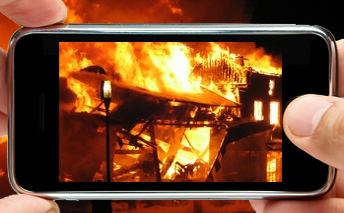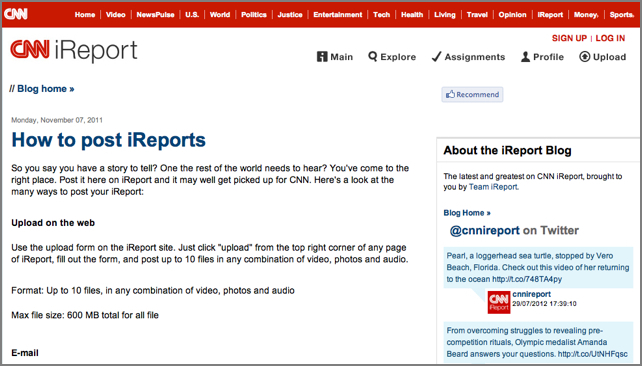
By Real Team (http://www.real.com/resources/citizen-journalism-sites/)
The world of the professional journalist, formally schooled and trained in delivering the ‘Who, What, Why, When, and Where’ of a news story, has been turned upside down and inside out. The legendary sign-off, “And that’s the way it is,” by renowned CBS News broadcast journalist Walter Cronkite, has lost the resonance it once had. Replacing it is an innumerable deluge of tweets, social sharing sites, blogs, and video news that relentlessly rains down on us 24/7. The advances in digital technology and the growth of the Internet have empowered a new era of ‘Citizen Journalism’ that has firmly planted a stake in the ground of today’s interconnected society.
BECOME A CITIZEN JOURNALIST AND CHANGE THE WORLD
Known by many names throughout the years, including guerrilla, public, grass roots, street or participatory, the concept of citizen journalism is simply that people who don’t have the journalistic academic background or correlating professional experience can and should be directly involved in journalism.
The Internet has proven to be the great equalizer of information dissemination. It enables people to instantly create and distribute information to and from people throughout the world, without the filters of what can and cannot be expressed. Using digital technologies and the Internet, citizen journalists can create, contradict or supplement news information for distribution simultaneously to local and worldwide audiences. Cell phones, with integrated still and video cameras, have been a great tool to help so many people to become citizen journalists in an instant.
The benefits of citizen journalism are two-fold. First, as a citizen, you have access to countless diverse perspectives, and even raw information happening in real-time on a global scale. Second, as a journalist, you can become a contributing member of that community by using technology as an outlet for your personal expression.
VIDEO NEWS BECOMING INTEGRAL PART OF CITIZEN JOURNALISM
There’s no question the Internet has been the enabling force of true citizen journalism today. Frankly, it can be hard to visit sites on the Internet without tripping over some flavor of it. The signature characteristic of citizen journalism has been side stepping the established channels and restrictions of professional news organizations. However, as we’ll see later, that is also changing.
The potential of citizen journalism took hold with the rapid expansion of the World Wide Web in the 1990’s. It allowed people to create a simple homepage and small websites where they could reach out to either a selected audience or the entire world to express their views. Today, many of those homepages have become blogs. Individuals shooting video of newsworthy events with a digital camera or the video recorder in a cell phone and then uploading the content to a blog to share with the world has become one of the more effective devices in a citizen journalist toolbox.
A big step up from blogging, and a more formal, better-financed alternative news source is The Huffington Post. Challenging the established media, it refers to itself as “The Internet Newspaper.” It, too, has a citizen journalist component where text, photographs, and video news can be submitted. This strategy has helped “Huff Post” flourish on the Internet. Advancing this commitment, they’ve partnered with UStream and created a video upload site that helps expand The Huffington Post’s capabilities for citizen journalists to deliver live, breaking news from mobile video devices.
For the less technically savvy, more causal, would-be citizen journalist, social networking websites like YouTube, Facebook and Twitter, offer easy ways to post videos online. These free services provide user-friendly platforms, with an extensive offering of tools and technology for various types of public and private communications using text, photos and video news content.
THE ESTABLISHMENT MEDIA ADDS VIDEO UPLOAD SITES
Typically, the institutional, card-carrying professional journalists tend to view ‘Citizen Journalists’ as interlopers; seen as amateurs without the skills, the fact-checking discipline nor an ethical code to temper the technical capability to publish whatever they choose. Luckily, not all in the business hold that view. In fact, one of the most prominent organizations, the Society of Professional Journalists, has established a Citizen Journalism Academy to encourage and educate aspiring amateur journalists.
The increasing effectiveness wielded by individual, non-professional, citizen journalists, has not been lost on the major television networks, cable channels and newspapers. So much so, they actively court input from aspiring citizen journalists by providing easy ways to submit stories via special video upload sites.
While all the major news organizations have programs of some sort, because of their groundbreaking history, we’ll focus on CNN as a model. Started in 1980, CNN was the first cable news channel offering television news coverage 24-hours a day.
CNN’s innovation continues in today’s Internet age with its “iReport” initiative. iReport actively solicits citizen journalists to submit news stories, especially those supported by photographs and video.

CNN takes it a step further by incorporating the professional term, “Assignment Desk” as part of the iReport package. Here, individuals can select from current “Open Stories” that CNN would like collaboration on from citizen journalists. Additionally, there are “News Beats” covering a range of ongoing topics gathered in “Assignment Groups” where contributors join with other citizen journalists who share that area of interest.
Something of a symbiotic relationship has developed among the broadcast and cable outlets with Internet sites like YouTube, Facebook, and Twitter. CNN regularly uses YouTube videos on its cable network, and also incorporates real-time tweets, instant messages, and Facebook comments from viewers into live programs.

Just for reference, here are a few other broadcast and cable news organizations that have similar citizen journalist programs: FOX uReport, NBC News Citizen Journalist, and CBS EyeMobile.
IS CITIZEN JOURNALISM RIGHT FOR YOU?
You can be a consumer, a contributor, or both. That’s your call.
News from citizen journalists worldwide has proven to be a valuable resource for capturing both real-time events and important stories that the establishment media doesn’t or can’t cover. Digital technologies, especially video, combined with the reach of the Internet make it easier than ever to publish your unique perspective to audiences large and small.
Which topics are you most interested in? What are your favorite sources of citizen journalism news? Are you a citizen journalist? Have you submitted any video news to video upload sites?
No comments:
Post a Comment